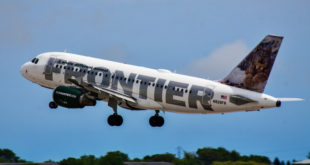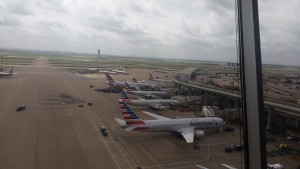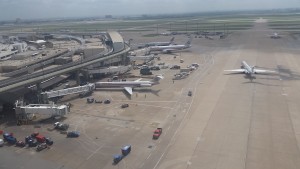One of the most frustrating experiences is when the pilot announces you’ve landed a half hour early–then comes back moments later to say there’s no gate available yet.
Eventually, you end up coming into the gate late.  But you could swear you saw some empty gates the entire time while you were waiting.
Yesterday, I got the opportunity to meet with some of American’s employees in their radio tower at Dallas-Fort Worth Airport thanks to American Airlines. Â Since DFW is such a big airport and American has such a big presence at it, they manage their gates on their own and pass on control to the FAA once planes make it out to the runway.
I got to go up in the tower:
Plus onto the roof:
I also got to check out some of the gate management software they use.
AND I got the opportunity to talk about a burning gate related question I had:
Why does there always seem to be five gates free when the pilot announces that there are no free gates?
Turns out that different planes from American’s fleet (and other airlines too) are incompatible when it comes to gate type.
So if you land in a mad dog in an airport that mostly has larger aircraft types, there’s probably only a few gates it can pull into.
This is my own thoughts on it now–so it would make sense for there to be a gate backup, especially when there are weather issues that are especially tough on the smaller plane types. Â Even if the bigger planes are getting out, there’s nowhere to put the little planes landing if the other small aircraft isn’t getting out.
On that note, American has some planes that land at DCA that don’t fit into any of the gates.  That’s why you have to take a bus on short hops so often.
But that’s not going to last much longer. Â They are building a way to board from enclosed areas (though stopped short of calling them actual gates).
 Le Chic Geek
Le Chic Geek







So you identified that AA has to bus some passengers at DCA because not all of their planes that land at that airport can fit at the gates. I didn’t realize they did that. It’s common at many non-U.S. airports to have remote stand boarding and de-planing from the Tarmac. I’ve not understood why that practice can’t be put in use more often at major U.S. airports, especially during IRROPS.
They have dedicated unloading areas at DCA with long, handicap friendly winding ramps that are protected from the elements. The buses have specific pick up and drop off areas, so it is like having a “gate”. They don’t just dump the people out on the runway.
Ah! You just mentioned a potential reason as to why we don’t do remote stand boarding / de-planing from the Tarmac in the U.S. – ADA requirements.